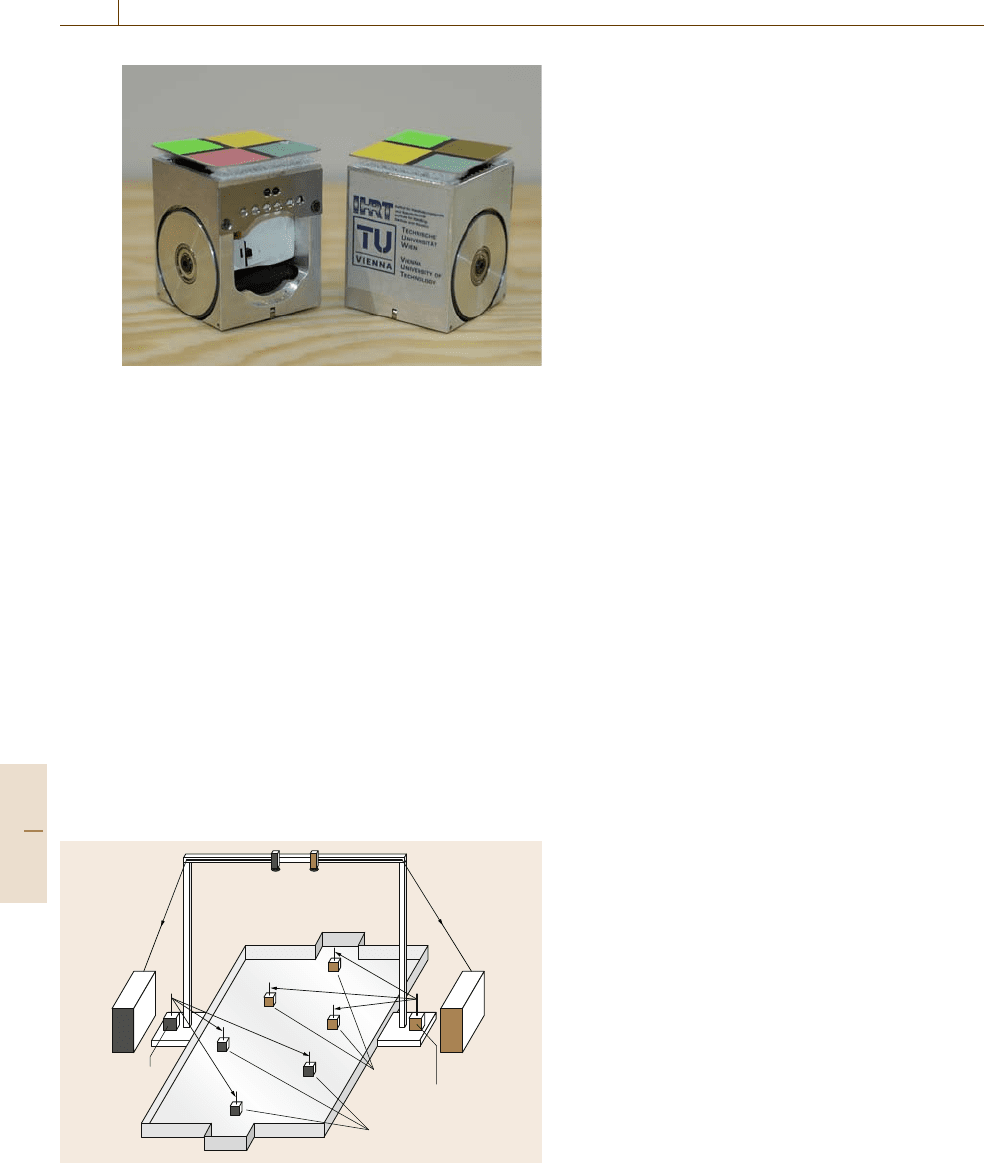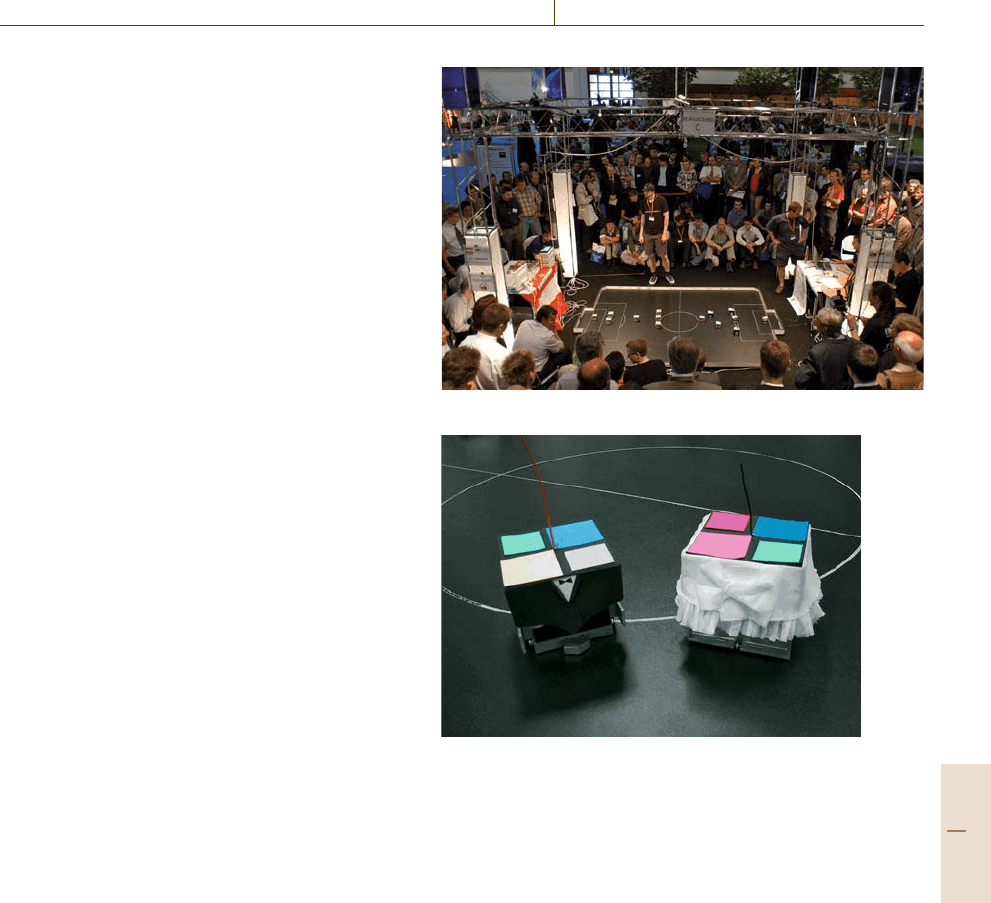Nof S.Y. Springer Handbook of Automation
Подождите немного. Документ загружается.


Automation in Sports and Entertainment 74.1 Robots in Entertainment, Leisure, and Hobby 1325
and Mac Minis running Linux because it can run on DC
power at relatively low wattage and produce less heat.
Examples of the latter included Mac Minis running on
Windows and an embedded version of Windows XP.
Annual Fire-Fighting Home Robot Contest. The main
challenge of this contest [74.21]istobuildanau-
tonomous, computer-controlled robot that can find its
way through an arena that represents a model house,
find a lit candle that represents a fire in the house, and
extinguish the fire in the shortest time. This task simu-
lates the real-world operation of an autonomous robot
performing a fire protection function in a real house.
The goal of the contest is to make a robot that can
operate successfully in the real world, not just in the
laboratory. Such a robot must be able to operate suc-
cessfully where there is uncertainty and imprecision.
Therefore, the dimensions and specifications listed in
the rules are not exactly what will be encountered at the
contest and are provided as general aids. However, the
size limits on robots are absolute and are enforced by
the judges.
Once turned on, the robot must be autonomous, i. e.,
self-controlled without any human intervention. Fire-
fighting robots are to be computer controlled and not
manually controlled devices.
A robot may bump into or touch the walls of the
arena as it travels, but it cannot mark, dislodge or dam-
age the walls in doing so. There will not be a penalty
for touching a wall, but there is a penalty for moving
along the wall while in contact with it. The robot cannot
leave anything behind as it travels through the arena. It
cannot make any marks on the floor of the arena that
aid in navigation as it travels. Any robot that deliber-
ately, in the judges’ opinion, damages the contest arena
(including the walls) will be disqualified. This does not
include any accidental marks or scratches made in mov-
ing around.
The robot must, in the opinion of the judges, have
found the candle before it attempts to put it out; for ex-
ample, the robot cannot just flood the arena structure
with CO
2
, thereby putting the candle out by accident.
Early competitions include the following:
Robot Golf Open. An example of a robot competition is
the 1996 robot contest called the Robot Golf Open. The
contest arena was a rectangular square of 2×2m, sur-
rounded by a 15cm high wall. The green was located in
the middle of the arena and was a 7cm high disc with
a diameter of about 40cm. Seven golf balls were ran-
domly placedon the arena. It was the task of the robot to
locate the balls, pick them up, and put them in some way
into the hole, with two points being given for each ball.
One point was given if the ball was only placed on the
green. It is emphasized here that the robots performed
the task autonomously, i.e., they made decisions as to
how to control themselves according to the software
running on the onboard computer based on sensory in-
formation. Two robots played golf against each other
for a period of 2min.
Environmental Control Robot Competition. The lat-
est contest with a vision system, held in the spring of
2001, was called environmental control; the robot task
was to locate three different kindsof garbagein anarena
and bring them to the correct container. The arena was
2×2m and contained containers at one side, three for
each robot. The garbage was either a bottle, a battery or
a pack of newspapers.
Other currently well-known competitions are:
Aerial Robotic Vehicle Competitions. The International
Aerial Robotics Competition [74.22] is the longest run-
ning aerial robotic event, held annually since 1991. This
competition involves fully autonomous flying robots
performing tasks that, at the time posed, are undemon-
strated anywhere worldwide. The competition is open
to universities and has had missions involving ground
object capture and transfer, hazardous waste location
and identification, disaster scene search and rescue,
and remote surveillance of building interiors by fully
autonomous robots launched from 3km. A series of mi-
cro air vehicle (MAV) events have been sponsored by
various organizations. Typically, these competitions in-
volve capability demonstrations rather than missions,
and may or may not involve full autonomy.
Ground Robotic Vehicle Competitions. In addition to
the DARPA Grand Challenge [74.23] there is also the
Intelligent Ground Vehicle Competition (IGVC)forau-
tonomous ground vehicles. The robots must traverse
outdoor obstacle courses without any human interac-
tion. This is an international student design competition
at university level and has held annual competitions
since 1992.
Underwater Robotic Vehicle Competitions. This is
a spin-off of the International Aerial Robotics Compe-
tition [74.24], and as such, carries through the theme
of full autonomy of operation, albeit in a subsurface
robotic vehicle. This is, since 1997, a collegiate com-
petition.
Part G 74.1

1326 Part G Infrastructure and Service Automation
International METU Robotics Days. The Middle East
Technical University (METU) Robotics Days [74.25]
are organized in Ankara, Turkey. There are robot com-
petitions from various categories in which original and
creative ideas take their part, while innovation is hon-
ored. Participants are always encouraged to share their
knowledge. International METU Robotics Days, apart
from holding competitions for those who would like
to challenge their skilled robots, also host profession-
als and academics interested in the field of robotics
to come together in lectures and workshop studies
with younger amateurs, giving them the opportunity
to take a closer look at this continuously developing
technology.
IEEE Micromouse competition. In the classical Micro-
mouse competitions [74.26], small robots try to solve
a maze in the fastest time. Micromouse competitions
were held first in Tampere Finland Technical University
around 1983–1985.
Botball Educational Robotics. Botball [74.27]is
a robotics competition for middle- and high-school
students. Organized by the KISS Institute for Practi-
cal Robotics, Botball encourages participants to work
constructively within their team, building basic com-
munication, problem solving, design, and programming
skills. Each team builds one or more (up to four) robots
that will autonomously move scoring objects into scor-
ing positions.
Mobile Autonomous Systems Laboratory Competition.
The Mobile Autonomous Systems Laboratory [74.28]is
one of the few college-level vision-based autonomous
robotics competition in the world. Conducted by and
for MIT undergraduates, this competition requires mul-
tithreaded applications of image processing, robotic
movements, and target ball deposition. The robots are
run with Debian Linux and run on an independent
OrcBoard platform that facilitates sensor-hardware ad-
ditions and recognition.
Wall-Climbing Competitions. There are two world-
wide known events. The Duke Annual Robo-Climb
Competition (DARC) [74.29] in the USA and the
Climbing and Walking Autonomous Robot (CLAWAR)
[74.30] competition in Europe. The task is to create in-
novative wall-climbing robots that can autonomously
ascend vertical surfaces of different materials with ob-
stacles.
AAAI Grand Challenges. The two Association for the
Advancement of Artificial Intelligence (AAAI) Grand
Challenges [74.31] focus on human–robot interac-
tion, with one being a robot attending and delivering
a conference talk, the other being operator-interaction
challenges in rescue robotics.
This is only a selection – there are a lot of other
robot competitions worldwide, mainly dedicated to BSc
students.
As an example, robot soccer will be described in
more detail below.
Robot Soccer
The fascinating idea of using small robot cubicles to
play soccer was born just a decade ago in Korea and
Japan and has since spread all over the world. Yearly
championships are even organized in different coun-
tries. From the scientific point of view, robot soccer is
one of the first applications of a MAS. The players –
robots or agents – have to solve a common task, i.e., to
win the game.
Robot soccer was introduced to develop intelligent
cooperative multirobot (agents) systems (MAS)andto
educate the young generation in these difficult scien-
tific and engineering subjects by playing. From the
scientific viewpoint the soccer robot is an intelligent
autonomous agent which carries out tasks with other
agents in a cooperative, coordinated, and communica-
tive way. Generally robot soccer is a good test bed for
the development of MAS. Furthermore it is also a good
tool for spending leisure time and for education [74.32].
In the future, production systems will become more
complex. Several independently working autonomous
mobile robots are working together, and therefore con-
flict situations in certain areas could appear, e.g., where
several robots gather at an intersection.In order to avoid
conflict situations and delays, and guarantee smooth
movement, robots should have thecapability to commu-
nicate and cooperate in orderto coordinate their actions.
Soccer is one of the best known sports worldwide. It
is exciting to watch how robots play the game. It is also
possible not only to watch the game but also to play
the game – human against computer, human against hu-
man – using a joystick as well as a keyboard. The big
question for common use is the price of the whole sys-
tem. With the development of electronic devices and
peripheries the cost is going down. For the realization of
interdisciplinary research, work should be done in areas
such as robotics, image processing, sensors, mechatron-
ics, communication, etc.
Part G 74.1

Automation in Sports and Entertainment 74.1 Robots in Entertainment, Leisure, and Hobby 1327
At the moment there are two robot soccer or-
ganizations in the world: the Federation of Interna-
tional Robot-Soccer Associations (FIRA) [74.33]and
RoboCup [74.34]. The objects and scope of both orga-
nizations are similar. The size, speed, acceleration of the
robots, the sizes of the playgrounds, and the numbers of
robots playing are different.
RoboCup. RoboCup is an international research and
education initiative. Its goal is to foster artificial intel-
ligence and robotics research by providing a standard
problem for which a wide range of technologies can be
examined and integrated.
The main focusof RoboCupactivities is competitive
football. The games are important opportunities for re-
searchers to exchange technical information. They also
serve as a great opportunity to educate and entertain the
public. RoboCup soccer is divided into the following
leagues:
Simulation League. Independently moving software
players (agents) play soccer on a virtual field inside
a computer.
Small-Size Robot League (f-180). Small robots of no
more than 18 cm in diameter play soccer with an orange
golf ball in teams of up to five robots on a field with size
bigger than a ping-pong table.
Middle-Size Robot League (f-2000). Middle-sized
robots of no more than 50cm diameter play soccer in
teams of up to four robots with an orange soccer ball on
afieldthesizeof12×8m.
Four-Legged Robot League. Teams of four four-legged
entertainment robots (Sony’s AIBO) play soccer on
a 3×5m field. The robots use wireless networking
to communicate with each other and with the game
referee. Challenges include vision, self-localization,
planning, and multiagent coordination.
Humanoid League. Biped autonomous humanoid
robots play in penalty kick and 2 versus 2 matches,
and technical challenges. This league has two subcat-
egories: kid-size and teen-size.
RoboCupRescue. The intention of the RoboCupRes-
cue project is to promote research and development in
this significant domain by involving multiagent team-
work coordination, physical robotic agents for search
and rescue, information infrastructures, personal digi-
tal assistants, standard simulator and decision support
systems, evaluation benchmarks for rescue strategies,
and robotic systems, which will all be integrated into
a comprehensive system in the future.
Federation of International Robot-Soccer Associa-
tions (FIRA).
Similar toRoboCup thereare also different
categories in this Robotsoccer World.
Micro Robot World Cup Soccer Tournament (MiroSot).
A match shall be played by two teams, each consist-
ing of 5 or 11 robots on a dark playground 220cm×
180cm for the middle league, 400cm×280cm for the
large league, with an orange golf ball (Fig.74.16). Only
three human team members, a manager,acoach,and
a trainer, are allowed on the stage. One host computer
per team, mainly dedicated to vision processing and
other location identification, is used. The size of each
robot is limited to 7.5cm×7.5cm×7.5cm. The height
of the antenna is not considered in deciding a robot’s
size.
Nano Robot World Cup Soccer Tournament (NaroSot).
Similar to MiroSot, but the size of the five robots is
limited to 4 cm×4 cm×5cm. They play with an or-
ange ping-pong ball on a playground 130 cm×90 cm
(Fig.74.17).
Kheperasot. The Kheperasot game is played by two
teams, each consisting of one robot player and up two
human team members. The robot is fully autonomous
with an onboard vision system. The human team mem-
bers are only allowed to place their robot on the field,
start their robot at the beginning of each round at thepo-
sition indicated by the referee before each round, start
Fig. 74.16 MiroSot robot [74.31]
Part G 74.1

1328 Part G Infrastructure and Service Automation
Fig. 74.17 NaroSot robot [74.31]
their robot when indicated by the referee, and remove
the robot from the field at the conclusion of the match.
They play with a yellow tennis ball on a playground
130cm×90cm.
Humanoid Robot World Cup Soccer Tournament
(HuroSotCup).
In this competition, the humanoid robot
has two legs (biped robot). The game is played us-
ing humanoid robots on a playground 340–430cm×
250–350 cm. The maximum size of the robots is
150cm, and the maximum weight is 30kg. The robots
have remote or auto control.
RoboSot. A match is played by two teams, each consist-
ing of one to three robots with maximum size 20cm×
20cm×(no limit in height) on a playground 260 cm×
220cm with a yellow with light green tennis ball. Only
three human team members, a manager,acoach,and
Host-
computer
team A
Host-
computer
team B
Communication
module
team B
Communication
module team A
Players
team A
Camera
Players
team B
Fig. 74.18 Overall system of robot soccer
a trainer, are allowed on the stage. The robots can be
fully or semiautonomous. In the semiautonomous case,
a host computer can be used to process the vision infor-
mation from the cameras onboard the robots.
Simulation Robot World Cup Soccer Tournament
(SimuroSot).
SimuroSot consists of a server, which
has the soccer game environments (playground, robots,
score board, etc.) and two client programs with the
game strategies. A 3-D color graphic screen displays
the match. Teams can make their own strategies and
compete with each other without hardware. The 3-D
simulation platform for 5 versus 5 and 11 versus 11
games are available at the FIRA web site [74.33].
MiroSot and NaroSot. The FIRA Mirosot and NaroSot
systems work as follow: A camera approximately 2m
over the playground delivers 60 pictures/s to the host
computer. With information from color patches on top
of the robots, the vision software calculates the position
and orientation of the robots and the ball. Using this,
the host computer generates motion commands accord-
ing to the implemented game strategy and sends motion
commands wirelessly to the robots.
A soccer robot is an excellent example of mecha-
tronics. Its main parts are wheels, drives, a power
source, a microprocessor, and a communication mod-
ule. All these parts have to be included in a very small
volume: a cube 7.5×7.5×7.5cm or a cuboid 4.0×4.0×
5.0cm. The soccer robots of a team (5–11 players) are
controlled by the team computer.
The robot itself has a drive mechanism, power
supply, electronic parts to control robot behavior, and
communication. Mostly digital proportional–integral–
differential (PID) controllers are used. The problem is
the setting of the controller parameters. Therefore fuzzy
control and neural networks are applied to adapt the
parameters.
The main problems are the power sources of such
robots. Usually batteries are approximately 50% of the
weight of the robot and have a lifetime of only 2h.
Worldwide there are already more than 150 teams
competing in regional and world championships.
As pointed out earlier, a soccer robot is an excel-
lent example of multidisciplinarity. For the construction
and manufacturing of the body, knowledge of mechan-
ical and, because of the small dimensions, precision
engineering is required. Electrical as well as control
engineering is necessary for the drives and the power
source. The control and communication board of the
robot is more or less applied electronics. A micro-
Part G 74.1

Automation in Sports and Entertainment 74.1 Robots in Entertainment, Leisure, and Hobby 1329
processor serves as an internal controller and is also
responsible for wireless communication with the host
computer. For these tasks and for the software of the
host computer fundamental knowledge in computer sci-
ence is necessary. The software of the host computer
includes online image processing, game strategies, con-
trol of the team’s own players, communication with and
between these, and the user interface.
Development of a robot soccer team therefore
requires the teamwork of specialists from various disci-
plines, having different thinking and talking a different
language. The project leader has to harmonize such
a team and must have at least basic knowledge of all
these necessary subjects.
One possibility to go into a broader market is to
replace conventional games in amusement parks and
restaurants. Therefore, as a first step in this direction,
the software had to be adopted to use also a joystick
to control each robot player. This offers the following
possibilities for playing:
•
Humans against humans (both teams controlled by
joysticks)
•
Humans against computer(only oneteam controlled
by joysticks)
•
Computer against computer (state of the art).
In contrast to soccer video games this new technol-
ogy offers a real-life feeling similar to that in a soccer
stadium.
A special application is robot dancing. Mirosot
robots are programmed for dancing and are judged on
criteria such as creativity and costumes. With a user-
friendly programming interface a 2min dance can be
created in half a day without any pre knowledge. As an
example Fig. 74.20 shows two Mirosot robots from the
soccer team of Vienna University of Technology dressed
in tuxedo and white robe ready for dancing the world-
wide well-known Blue Danube Waltz.
Until now the robots are completely unintelligent;
they have no sensors and are controlled by the host
computer. In the future robots will be more and more
intelligent and will be equipped with different sensors
(ultrasonic, infrared, laser, etc.). This offers the pos-
sibility for robots to adapt the commands of the host
computer.
Future developmentswill be towards humanoid soc-
cer players. A humanoid soccer playing robot has to:
Fig. 74.19 Overall view of robot soccer
Fig. 74.20 Dancing couple for a Vienna waltz
•
Be able to accelerate and slow down as fast as
possible
•
Keep its balance all the time, even after a crash with
another robot
•
Localize itself on the field
•
Localize the ball
•
Localize the opponents
•
Make autonomous decisions regarding which ac-
tions to take.
As a first step some producers are offering robots
with four or six legs at a high price. In some years play-
ers with two legs will probably be available – then we
can start the first soccer games with humans against
robots.
Part G 74.1

1330 Part G Infrastructure and Service Automation
74.2 Market
Consumers showed an astonishingly quick appreciation
of the new products in this field, especially of Furby,
the first animatronic pet marketed on a larger scale, in
February 1998. This pet’s popularity is on the one hand
due to the well-prepared marketing campaign that was
organized for its introduction and on the other hand to
market mechanisms outside the company’s control that
made these little creatures a must-have item in practi-
cally every child’s room.
As this product proved to be nearly perfect for the
manufacturer, combining low production costs with ex-
tremely high customer demands, many other companies
copied the product or designed other robotic pets based
on the successful concept in the subsequent years to
participate in this expanding market as well.
By far the most famous of these personal com-
panion robots is AIBO, which sold out over the
Internet within minutes, regardless of the fairly high
price. For the second generation, introduced in the
market at the end of 2000, a large number will be
sold.
It is safe to assume that this market will continue
to expand, with newly developed and technically even
more refined products entering the market. Thus other
companies in this market will have to keep pace and
develop further products themselves.
Even in related fields such as robot soccer, robots
are likely to find their way to the toy market as soon as
these systems can be produced in larger quantities and
at a lower price than today.
74.3 Summary and Forecast
Mobile, intelligent robots are now available on the mar-
ket. The number of these robots in use will dramatically
increase inthe next year. Oneof the main application ar-
eas will be the field of entertainment, leisure, and hobby
and robot competitions.
Well-known scientists engaged in robotic research,
and who dare to make forecasts not only for the imme-
diate future of service robotics but for the more distant
future, also believe that the evolution of service robots
will basically happen in several stages, being closely
linked to progress in computer technology.
The semiconductor market has seen a series of
market-driving waves, from the analog wave to the first
digital wave, in which the PC was central, to the second
digital wave, in which the digital consumer and net-
work were central. After these waves, scientists expect
a robotics wave to occur. So the personal robot mar-
ket will become more important than the PC market.
An estimation of one scientist is that a humanoid robot-
soccer team will win against the world champions by
2050.
We are talking about entertainment robots in gen-
eral, beyond QRIO. It would be desirable to develop
is a robot companion for human beings. For instance,
a robot can hold things in its memory indefinitely. The
hardware might break down over the course of many
years, but by taking the memory stick and putting it
into a new robot, you could transfer those memories
to it. In so doing, one can share with it a short time’s
worth of memories and knowledge and visions. In some
ways, a robot could be the ultimate companion. Yet an-
other idea would be a robot that listens to you. The
basis for this is the active listening method of coun-
seling, wherein the counselor gives no information but
simply listens. A robot can do that too. A robot can lis-
ten to complaints, share information, and be a counselor
anytime, day or night.
Therefore we will probably see the following
generations:
First Companion Robot Generation – 2010
Mobile, human-sized universal service robots, being as
intelligent as a lizard, will be able to perform everyday
routine work such as cleaning floors, remove garbage
or dust furniture. The required computing power for
such a robot would be approximately 5 Mips (5 million
instructions per second).
Second Companion Robot Generation – 2020
The subsequent robot generation, also designed to
assist humans in their everyday activities, performs
janitorial services, or simply entertains them, features
an advanced processor capable of computing about
100000 Mips, thus boosting the intelligence level of the
system to that of a mouse. These robots can already be
trained using praise and censure.
Third Companion Robot Generation – 2030
With computing poweradvancingfurther to 5×10
6
Mips,
the robotic system reaches the intellect of a monkey.
Part G 74.3

Automation in Sports and Entertainment References 1331
Forth Companion Robot Generation – 2040
Within 40 years from now, the forth generation of
service robots should be capable of abstracting and gen-
eralizing problems like a human, thus performing not
only routine tasks, but tasks that require preparation
and planning as well. Therefore the existence of com-
panies that do not employ a single human worker any
more, besides their autonomous robots, might be well
conceivable. We are looking forward to what will be
realized.
74.4 Further Reading
•
P. Corke, S. Sukkarieh: Field and Service Robotics,
Results of the 5th International Conference,
Springer Tracts Adv. Robot. 25 (Springer, Berlin,
Heidelberg 2006)
•
G. Engelberger: Services. In: Handbook of Indus-
trial Robotics, ed. by S.Y. Nof (Wiley, New York)
pp. 1201–1212
•
J.F. Engelberger, Robotics in Service (Kogan Page,
London 1989)
•
H.R. Everett: Sensors for Mobile Robots: The-
ory and Application (A.K. Peters, Wellesley
1995)
•
S. Haddadin, T.S. Laue, G. Hirzinger: Foul 2050:
thoughts on physical interaction in human–robot
soccer, 2007 IEEE/RSJ Proc. Int. Conf. Intell.
Robot. Syst. (2007) pp. 3243–3250
•
G. Lakemeyer, E. Sklar, D. G. Sorrenti, Takahashi
(Eds.): RoboCup 2006: Robot Soccer World Cup X
(Springer, Berlin, Heidelberg 2007)
•
E. Osawa, H. Kitano, M. Asada, Y. Kuniyoshi,
I. Noda: RoboCup: the robot world cup initiative,
ICMAS-96 Proc. 2nd Int. Conf. Multi-Agent Syst.
(1996) p. 454
•
R. D. Schraft, G. Schmierer: Service Robots
(A.K. Peters, 2000)
•
J. Schmidhuber: Developmental robotics, optimal
artificial curiosity, creativity, music, and the fine
arts, Connect. Sci. 18(2), 173–87 (2006)
References
74.1 P. Kopacek: Advances in robotics, Proc. 10th Int.
Conf. Comput. Aided Syst. Theor. – EUROCAST 2005
(Springer, Berlin, Heidelberg 2005) pp. 549–558
74.2 J.W. Kim: Unpublished Transparencies (Summer-
school, Kaist, Daejon 2006)
74.3 G. Fischer: Robots in entertainment leisure and
hobby. Diploma Thesis (Vienna University of Tech-
nology, Vienna 2000)
74.4 P. Kopacek, M.W. Han: Robots for entertainment,
leisure and hobby, Proc. CLAWAR/EURON/IARP Work-
shop Robot. Entertain. Leisure Hobby (Vienna 2004)
pp. 1–6
74.5 Dictionary of Contemporary English, 2nd edn.
(Longman Group UK Ltd., Essex 1987)
74.6 Merriam–Webster’s Collegiate Dictionary (Merriam–
Webster Inc., Springfield 1999)
74.7 http://mindstorms.lego.com
74.8 http://www.megasaurus.com
74.9 http://www.transaurus.com
74.10 http://www.cs.uni-bonn.de/˜rhino/tourguide/
74.11 http://www.cs.cmu.edu/˜minerva/tech/
74.12 http://www.boxerjocks.com
74.13 P. Kopacek, M.W. Han: New concepts for humanoid
robots, Proc. FIRA RoboWorld Congr. (Dortmund,
2006) pp. 108–111
74.14 http://en.wikipedia.org/wiki/QRIO
74.15 http://www.robonova.com
74.16 http://www.wowwee.com/products_robotics
74.17 http://en.wikipedia.org/wiki/Robot_competition
74.18 A.J. Baerveldt, T. Salomonsson, B. Astrand: Vision-
guided mobile robots for design competition, IEEE
Robot. Autom. (2003) pp. 38–44
74.19 http://www.robogames.net
74.20 http://www.darpa.mil/grandchallenge/
74.21 http://www.trincoll.edu/events/robot/
74.22 http://avdil.gtri.gatech.edu/AUVS/IARCLaunchPoint
74.23 http://www.igvc.org
74.24 http://www.auvsi.org/competitions/water.cfm
74.25 http://www.roboticsdays.org
74.26 http://micromouse.cannock.ac.uk
74.27 http://www.bootball.org
74.28 http://maslab.csail.mit.edu
74.29 http://robotics.pratt.duke.edu/roboclimb/
74.30 http://www.clawar.org
74.31 http://www.aai.or
74.32 P. Kopacek, M.W. Han: Mini robots for soccer, Proc.
12th Int. Conf. Comput. Aided Syst. Theor., EUROCAST
(Springer, Berlin, Heidelberg 2007) pp. 342–344
74.33 http://www.fira.net
74.34 http://www.robocup.org
Part G 74
“This page left intentionally blank.”

1333
Automati
Part H
Part H Automation in Medical and Healthcare Systems
75 Automatic Control in Systems Biology
Henry Mirsky, Santa Barbara, USA
Jörg Stelling, Basel, Switzerland
Rudiyanto Gunawan, Singapore,
Neda Bagheri, Cambridge, USA
Stephanie R. Taylor, Waterville, USA
Eric Kwei, Santa Barbara, USA
Jason E. Shoemaker, Santa Barbara, USA
Francis J. Doyle III, Santa Barbara, USA
76 Automation and Control
in Biomedical Systems
Robert S. Parker, Pittsburgh, USA
77 Automation in Hospitals and Healthcare
Brandon Savage, Chalfont St Giles, UK
78 Medical Automation and Robotics
Alon Wolf, Haifa, Israel
Moshe Shoham, Haifa, Israel
79 Rotary Heart Assist Devices
Marwan A. Simaan, Orlando, USA
80 Medical Informatics
Chin-Yin Huang, Taichung, Taiwan
81 Nanoelectronic-Based Detection
for Biology and Medicine
Samir M. Iqbal, Arlington, USA
Rashid Bashir, Urbana, USA
82 Computer and Robot-Assisted Medical
Intervention
Jocelyne Troccaz, La Tronche, France

1334
Automation in Medical and Healthcare Systems. Part H Most of the automation inventions, innovations
and devices in medical and healthcare systems have just emerged in the recent two decades, and many more are
moving out of research labs to hospitals and homes. This part explains the exponential penetration and main con-
tributions of automation to the health and medical well being of individuals and societies. First, the scientific and
theoretical foundations of control and automation in biological and biomedical systems and mechanisms are ex-
plained, and their significant value for useful implementation and application is detailed. Then, specific areas are
described and analyzed in: implantable devices; medical robotic solutions and techniques for a range of medi-
cal problems and medical interventions; diagnostics and testing procedures and tools, including the emergence
of nano-devices; and the significant progress in medical informatics and medical records and instrumentation.
Available, proven, and emerging automation techniques and design for better cost savings and quality assurance
in healthcare delivery, and elimination of hospital and other medical errors are also addressed in this part.
